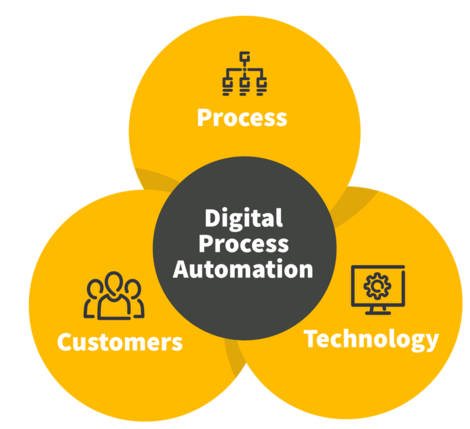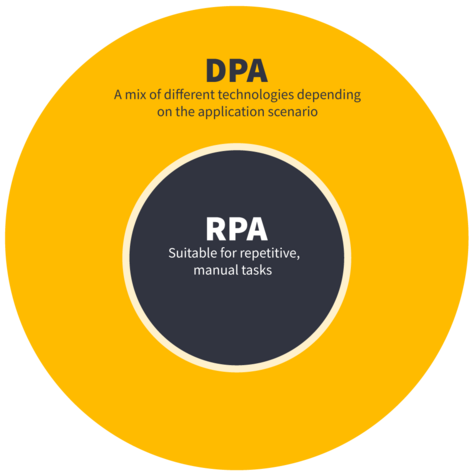
Digital Process Automation: Turning inefficient processes into competitive advantages
- Last updated , created on
- Reading time
- Category Process automation insights
More and more companies are automating their business processes in order to become faster and more efficient, minimize errors, and create information transparency. Different approaches can be taken to fulfill this aim. One approach is called Digital Process Automation (DPA). On this page you will learn what is behind this approach and how you can use DPA technology to your advantage.
What is Digital Process Automation?
Digital Process Automation (DPA) is a holistic approach to the end-to-end digitalization and automation of business processes. End-to-end means that companies extend their digital processes outside the usual boundaries. The aim is, for example, to involve external process participants, such as customers, service providers, and partners. This allows companies to interact smoothly without media disruptions.
From a technological point of view, Digital Process Automation is based on traditional Business Process Management (BPM). BPM technology ensures that business processes can be conducted in a stable, accurate, streamlined, efficient, and economical manner. DPA adopts this approach and develops it further. Emphasis is placed on improving the customer experience and optimizing the provision of information for employees.

What is Digital Process Automation?
Digital Process Automation (DPA) is a holistic approach to the end-to-end digitalization and automation of business processes. End-to-end means that companies extend their digital processes outside the usual boundaries. The aim is, for example, to involve external process participants, such as customers, service providers, and partners. This allows companies to interact smoothly without media disruptions.
From a technological point of view, Digital Process Automation is based on traditional Business Process Management (BPM). BPM technology ensures that business processes can be conducted in a stable, accurate, streamlined, efficient, and economical manner. DPA adopts this approach and develops it further. Emphasis is placed on improving the customer experience and optimizing the provision of information for employees.
Advantages of Digital Process Automation
Digital Process Automation offers a whole range of advantages. It guarantees transparent, optimized business processes and a better customer and employee experience. Your business processes will also be accelerated through the automation of manual and repetitive tasks. At the same time, your employees will be able to focus on important, business-related aspects. Your team will spend considerably less time on researching the current status of individual processes.
Additional advantages of Digital Process Automation:
- Cost savings
- Extremely precise process execution
- Significant reduction in loss of information within processes
- Greater flexibility in process management: Business processes can be adapted quickly
- Thorough process documentation (compliance with applicable regulations, audit security)
- Better traceability of decisions
- Scalability of routine tasks
Areas of application of DPA
DPA is suitable in principle for small, standard procedures as well as complex, individual processes. Digital Process Automation is particularly constructive for processes that influence the Customer Experience (CX). Classic examples include tender and order processes, credit approvals, and the onboarding of new customers. In the latter case, Digital Process Automation prevents your team’s productivity from being compromised by large amounts of paperwork. The necessary forms are generally completed automatically. This minimizes errors and simplifies the process. In addition, all participants automatically receive the onboarding process status.
You can also use Digital Process Automation to update, optimize, and standardize obsolete business processes. This reduces your costs and compliance risks in equal measure. DPA also offers possibilities for integrating elements such as reminders, approvals, and escalations into your workflows. Business rules ensure that processes are efficient from start to finish.
Further application examples of Digital Process Automation:
- Replacing paper documents and Excel spreadsheets with digital, (partially) automated forms
- Linking digital forms with workflows
- Pooling data from different systems and business areas
- Creating automated reports for application purposes (e.g. monitoring team performance, overseeing decisions, and identifying bottlenecks)
Webinar Recording
Practical tips - the right way to approach the digitisation and automation of your business processes
DPA and RPA: Digital Process Automation versus Robotic Process Automation
The terms Digital Process Automation (DPA) and Robotic Process Automation (RPA) are sometimes used synonymously. However, this is not accurate, as they represent two different approaches to process automation.
With RPA, software robots take on the role of human employees. Bots interact like real people with existing systems and repeatedly perform defined tasks. For example, they can transfer data from a database to an ERP system. Robotic Process Automation is particularly useful for less demanding, standardized activities which are repeated frequently.

DPA and RPA: Digital Process Automation versus Robotic Process Automation
The terms Digital Process Automation (DPA) and Robotic Process Automation (RPA) are sometimes used synonymously. However, this is not accurate, as they represent two different approaches to process automation.
With RPA, software robots take on the role of human employees. Bots interact like real people with existing systems and repeatedly perform defined tasks. For example, they can transfer data from a database to an ERP system. Robotic Process Automation is particularly useful for less demanding, standardized activities which are repeated frequently.
The differences between DPA and RPA can be summarized as follows:
| Digital Process Automation (DPA) | Robotic Process Automation (RPA) |
|---|---|
| Focus on end-to-end processes | Focus on tasks |
| Processes can be digitalized and automated from start to finish with a combination of technologies | Software robots automate repetitive human tasks |
| Aims: more efficient processes, information transparency, improved customer and employee experience | Aims: tactical efficiency, reduced costs, easing employee workload |
| Transformation of existing processes | No change to existing processes |
| Expansion, optimization, and standardization of processes | Automation of processes |
DPA is generally the preferred option for the comprehensive digital transformation and automation of your business processes. Digital Process Automation uses different technologies in this context. These include RPA and machine learning, for example.
What JobRouter® DPA software offers
In order to implement Digital Process Automation successfully within your company, you need a suitable DPA tool. This is where JobRouter® comes in. JobRouter® is more than a DPA software package. The digitalization platform connects processes, data, and documents together in a particular way. It also combines DPA and RPA technology to create a whole range of new process automation possibilities.
One example is the automation of business processes involving several legacy systems or solutions developed in-house. This kind of software often does not have interfaces and is difficult to connect. DPA interface technologies are therefore reaching their limits. This type of scenario does not present a challenge for RPA, however, as bots can operate any system and deal with data transfers.
If the process requirements change frequently, RPA will, on the other hand, reach its limits. In this case, the user-friendly DPA components of JobRouter® come into play. They are based on low-code development and enable specialist departments to adapt their business processes and rules quickly without any specific IT knowledge.
By combining DPA and RPA, JobRouter® allows you to achieve rapid end-to-end digitalization and automation of your business processes. You will also be able to operate flexibly and react to changing framework conditions within a short time span.
Overview of the key features of JobRouter® Digital Process Automation:
- High process functionality
- Low-code approach for process digitalization and automation
- Rapid application development
- Keep it simple – in contrast to highly complex solutions
- Wide ranging use within the company
- Simple, flexible change management
- Fewer barriers to entry
- Attractive conditions (pay-as-you-grow)
Conclusion: DPA tools improve digitalization and customer focus
To summarize, Digital Process Automation allows you to improve and automate your business processes and tailor them even more to the needs of your customers and employees. The end-to-end approach is a great advantage in this respect. Not only does it allow for the digital mapping of individual tasks, it also helps to transform your business processes holistically. The adoption of digital process automation is made easy thanks to intuitive, scalable low-code platforms such as JobRouter®. Start with small, simple workflows and gradually automate increasingly complex processes in a flexible manner adapted to your needs.

